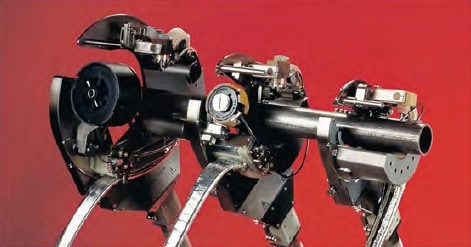
What is a welding head? Is it the device holding the electrode when performing manual welding? Or is it the complex device encapsulating the tube or pipe when automatically creating a weld? To a non-welder, this is a genuine curiosity. But the people working in the welding industry will know that the weld head is entirely different from weld guns or stingers, as seen when performing stick or flux-cored welding.
Welding heads can be best explained when addressing orbital TIG (Tungsten Inert Gas) welding as the component facilitating the movement of the welding torch. The scope of functioning of these welding heads can differ depending on the type of weld being performed. This article will discuss welding heads, their different types, and their functioning in detail.
Definition of a Welding Head
American Welding Society (AWS) describes a welding head as “The part of a press or projection welding machine fitted under the actuator to make the electrode travel in a straight line onto the workpiece.”
When performing orbital welding, the welding head lines up at the fusion axis, holds the tungsten electrode in place, and rotates it around the circumference of the pipe or tube being welded. In that sense, the welding head can be called an “electrode holder,” but its meaning can be more generic — applicable to stingers or weld guns. However, unlike welding heads, stingers hold the electrode when performing manual welding and weld guns are specific to wire feed devices primarily used in MIG (Metal Inert Gas) or FCAW (Flux Cored Arc Welding).
When orbital welding, the weld head serves the following critical functions –
- Hold the electrode in place
- Applies force to the workpiece
- Facilitate the flow of weld current
- Maintain heat input control
Accompanying the weld head during orbital GTAW is the gas supply nozzle which provides a constant supply of shielding gas to the weld head to create a high-purity weld. In most cases, the welding head also comes with cooling lines (air or water-cooled) to prevent overheating and damaging the weld. Paired with the right power supply, the welding head offers high-quality fusion for various applications. However, the crucial step in achieving this quality is selecting the welding head.
Hot Wire GTAW With Helium
When conducting helium GTAW, there are a few things to take note of –
- Pure helium will require DCEN (Direct current Electrode Negative) when GTAW welding.
- When working with AC-GTAW, it is preferred to have 25% helium in the gas mixture.
- More than 25% helium in the mixture can create an unstable arc during AC-GTAW.
Apart from this helium content, it is important to understand the heat requirement for certain thicknesses of metal. While thinner metal can be easily fused with traditional GTAW, thicker metal will require the use of filler metal. It is possible to use helium for hot-wire GTAW so thicker metals can be welded with precision.
Hot wire GTAW provides a much higher deposition rate which is further enhanced by the thermally conductive properties of helium. The desired gas mixture is usually 75% helium with 25% argon but pure helium may also be used. Controlled supply of the gas for hot-wire helium GTAW means wider profile and deeper penetration with excellent results along the root pass. For much thicker walled pipes, hot-wire narrow groove welding with helium GTAW can weld with precision for up to several hundred millimeters.
Welding Head – Types and Selection Criteria
Based on the functioning of the weld head and the type/thickness of metal it serves, the welding head can be distinguished as — an open welding head and a closed welding head. First, let’s look at some of their functionalities.
| Open Welding Head | Closed Welding Head |
|
A single weld head can weld pipes of different diameters. The weld head is open, adjustable, and flexible. The shielding of the weld puddle is dependent on the flow of inert gas from the gas supply nozzle. It is suitable for welding large pipes with considerable thickness. The flexibility and portability allow open weld heads to be used in spaces with tighter tolerances or in remote locations. |
The weld head can only be used for specific diameters. The weld head clamps around the workpiece to create an enclosed inert environment for welding, reducing the puddle’s exposure to contamination. It is suitable for welding thin-walled tubes. Generally desired for applications, the closed welding head may not be effective for on-site welding and are difficult to operate in tighter spaces. |
Apart from the choice of open or closed welding head, the choice of electrode and weld head configuration are also important selection factors. The choice of inline or offset configuration can be important in terms of part accessibility and weld design.
AMI’s Orbital Welding Head
AMI provides a wide range of welding heads compatible with orbital GTAW of a wide range of pipes, tubes, and tube sheets. Our range of weld heads includes– Model 8 Series and Model 9 Series closed weld heads and Model 79 Series open weld heads that are adjustable and provide precision welding ability for a wide range of applications. With a selection of the right AMI welding head, your orbital welding project is sure to have high-quality, high-purity, precision results.
Arc Machines, Inc., a leading provider of orbital welding technology, provides a wide range of precision welding heads that will help you meet strict manufacturing and sanitary standards for your industry-specific application. For inquiries regarding products, contact sales@arcmachines.com. For service inquiries, contact service@arcmachines.com. Contact us to arrange a meeting. Arc Machines welcomes the opportunity to discuss your specific needs.




